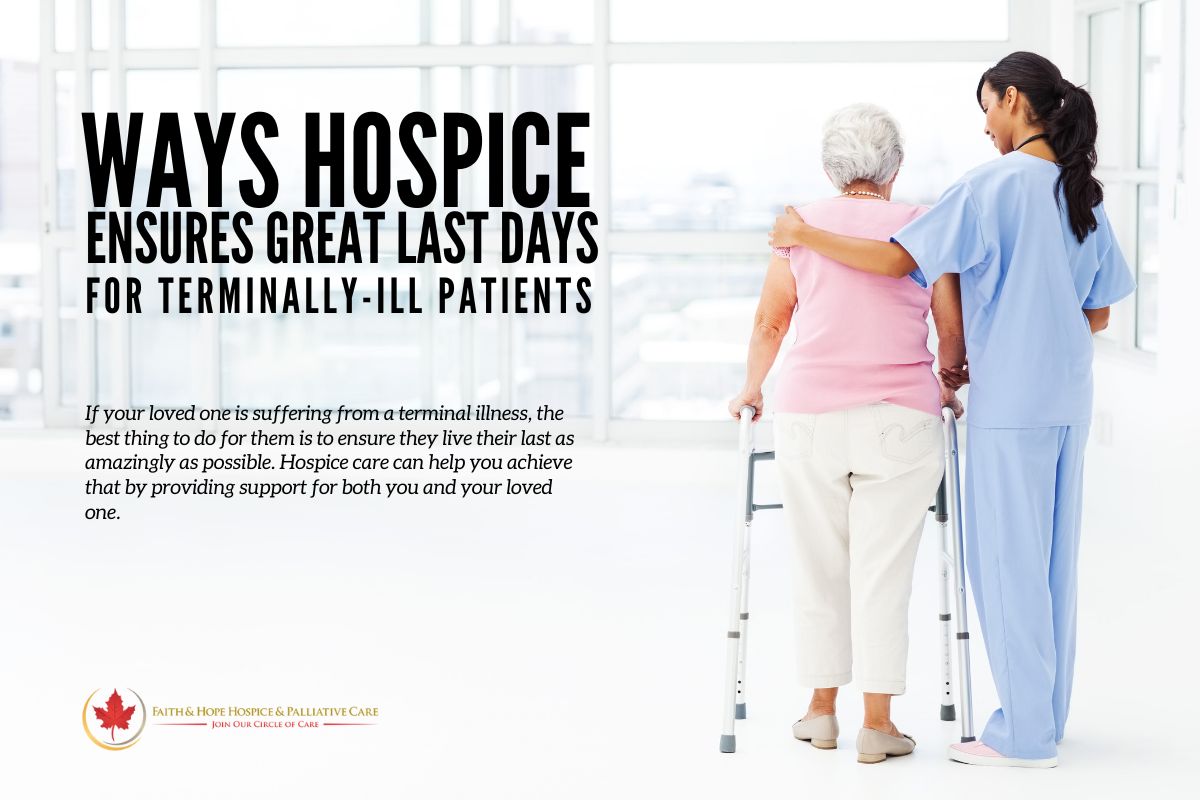
- By: administrator
- Blog
- No Comments
A terminal illness is a challenging and emotionally taxing experience for patients and their families. In such difficult times, Glendale hospice care emerges as a compassionate and specialized approach that focuses on enhancing the quality of life for individuals in the final stages of life. Hospice provides supportive services tailored to terminally ill patients’ unique and pressing needs, aiming to ease pain, offer emotional support, and preserve dignity during their last days. That way, they can leave this world with as minimal physical and emotional pain as possible, comforting the loved ones they’re leaving behind.

This article explores how hospice care is crucial in enabling terminally ill patients to live better during the end-of-life journey.
1. Pain and Symptom Management
Hospice care strongly emphasizes pain and symptom management to ensure terminally ill patients are as comfortable as possible. Skilled healthcare professionals work together to create personalized care plans, addressing the patient’s unique needs and pain levels. For example, they could have physical therapy sessions for patients with mobility issues, utilize pain relievers for those experiencing discomfort, and meditation modalities for those suffering from panic and anxiety disorders.
By providing appropriate medications, therapies, and counseling, hospice effectively alleviates physical discomfort, allowing patients to experience a higher quality of life during their final days.
2. Emotional and Psychological Support
Terminal illness can evoke many emotions, including fear, anxiety, and depression. Hospice care includes a multidisciplinary team, including social workers, who emotionally support patients and their families. This support helps patients come to terms with their situation, process emotions, and improve their mental well-being, fostering a sense of peace and acceptance during their end-of-life journey.
Examples of how hospice can alleviate these negative feelings include having fun hobbies like cross-stitching or games that patients can distract themselves with, hosting service animals to provide tender love and care to their patients, and providing therapy sessions to patients and loved ones.
3. Improved Communication and Decision-Making
Hospice care encourages open and honest communication between patients, their families, and the healthcare team. Communication is essential for hospice care, as it fosters understanding, trust, and empathy between patients, families, and healthcare professionals. Open and honest communication allows patients to express their preferences, concerns, and end-of-life wishes, enabling caregivers to provide personalized and compassionate care. It also helps address emotional and psychological needs, leading to better decision-making, enhanced emotional support, and improved overall quality of life during the end-of-life journey.
4. Dignity and Respect
Preserving the dignity of terminally ill patients is one of the fundamental principles of hospice care. Terminally ill patients deserve dignity and respect in their final days because everyone deserves to be treated with compassion and kindness regardless of their health condition. Preserving dignity fosters emotional well-being, allows patients to maintain control, and ensures a more peaceful and meaningful end-of-life journey.
By focusing on the patient’s unique needs, preferences, and values, hospice caregivers ensure that every aspect of care respects the individual’s dignity. This approach fosters a caring and compassionate environment that enhances the patient’s self-worth and self-respect, promoting a peaceful transition.
5. Spiritual Care
Hospice care acknowledges that spirituality plays an essential role in the lives of many individuals. Spirituality provides comfort and meaning to terminally ill patients in hospice care. It offers peace and purpose, helping patients find solace in their beliefs and faith.
Spiritual support from spiritual care coordinators assists in coping with fear and anxiety, promoting emotional well-being during their end-of-life journey. Their support can include prayer, rituals, or simply providing a listening ear, helping patients find comfort and meaning during their final days.
6. Respite for Family Caregivers
Hospice care focuses on the patient’s well-being and recognizes the toll terminal illness can take on family caregivers. Family caregivers face numerous challenges while caring for terminally ill patients, including emotional stress, physical exhaustion, financial strain, and time constraints. Witnessing their loved one’s suffering can be emotionally draining, and balancing caregiving with work and personal life can become overwhelming. Additionally, the lack of support and resources without hospice can exacerbate the difficulties.
Hospice teams offer respite, enabling family members to take a break from their caregiving responsibilities without compromising the patient’s needs. This support allows caregivers to recharge emotionally and physically, ensuring they can continue providing the best possible care for their loved ones.
7. Home-Based Care
Faith and Hope Hospice provides home-based care, allowing terminally ill patients to remain in the comfort of their own homes during their final days. It allows patients to be surrounded by loved ones, fostering emotional support and reducing stress. Home care ensures personalized attention tailored to patients’ unique needs and preferences. Additionally, it offers respite for family caregivers, enabling them to continue caregiving with less burden while promoting the patient’s dignity and autonomy in their own space.
8. Enhanced Communication with Loved Ones
Hospice care actively encourages and facilitates communication among family members during the end-of-life process. Hospice enhances communication between terminally ill patients and their loved ones through open and supportive dialogues facilitated by healthcare professionals. The hospice team guides families in navigating difficult conversations about the patient’s wishes, ensuring everyone’s concerns are addressed. This improved communication fosters understanding, emotional connection, and resolution of unresolved issues, allowing patients and their loved ones to share meaningful moments and create lasting memories during the end-of-life journey.
9. Bereavement Support
Hospice care extends its support beyond the death of a patient. Bereavement services are available to the family members and loved ones left behind, offering counseling and assistance to cope with grief and loss. This ongoing support helps individuals navigate the grieving process and promotes healing after the patient’s death.
Conclusion
Hospice care serves as a beacon of light during the darkest days of terminal illness, providing support, comfort, and compassion to patients and their families. Through effective pain management, emotional and psychological support, improved communication, and preservation of dignity, hospice helps terminally ill patients live better during their last days. By focusing on the patient’s physical, emotional, and spiritual well-being, hospice care fosters an environment of love and understanding, allowing patients to embrace their end-of-life journey with grace and peace.
